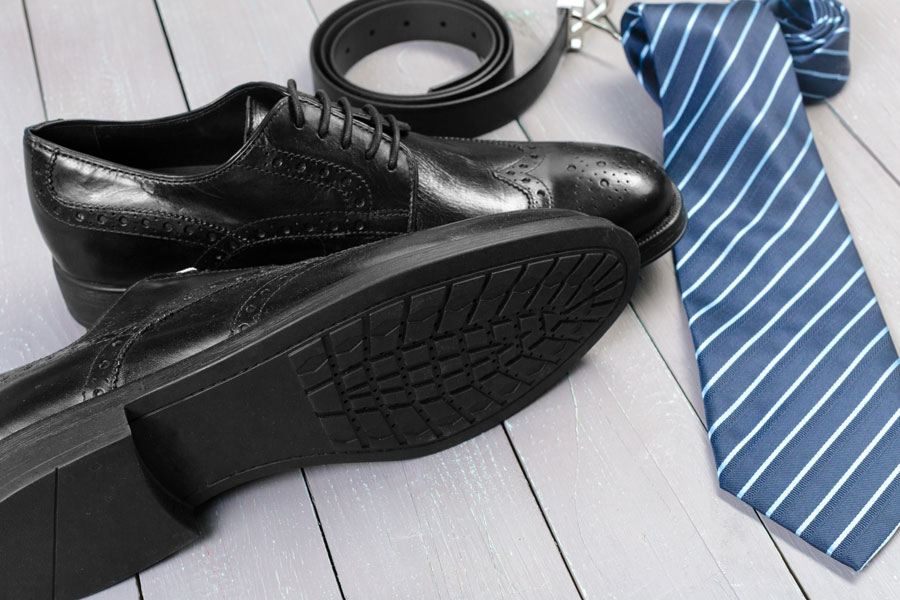
Men’s Dress Shoes – Anatomy of Men’s Dress Shoes
Quality construction is important when choosing men’s dress shoes (or any shoe for that matter) because it will ultimately determine how long the show will last. With proper maintenance a good dress shoe should last for years, that’s why it is so important to purchase wisely.
A lot goes into both the construction and materials used to create a quality men’s shoe. Knowing how the different types of shoe construction is the first step to knowing if you are choosing a quality shoe. We found the follow information from “Real Men, Real Style” and thought we’d share it today. It tells you everything you need to know about shoe construction and terminology.
Key terms you should know:
The Upper: The leather that covers the foot when a shoe is worn. The upper has distinct parts such as the vamp, heel, eyelets, toe cap, quarter, etc., but for the purposes of this article, all those components will be referred to as the upper.
The Insole: The material that is inside the shoe that will touch the foot or sock
The Outsole: This is found on the exterior of the sole as well as the material that contacts the ground when standing or walking.
The Welt: Generally found on shoes with premier construction, and is a strip of leather that runs around the border of the outsole. Attaching the upper to the outsole is its main function.
The Last: Three-dimensional model of a foot. It is used in design to create the shape of the shoe and to maintain the form and keep stability during the construction of the piece.
NOTE: Design and construction are not interchangeable terms. Design refers to things like the type of leather, stitching, perforations, and other intricate details that make a shoe spectacular. Construction, again, is the method that is used to attach the sole of the shoe to the upper.
Construction of Dress Shoes:
Now that we have some definitions to refer to, let’s begin with the least expensive type of construction and end with the most expensive.
Cementing
Method: After the upper is shaped around the last and all the details are finished, the sole is attached with an adhesive that’s commonly known as cement. Think of it as an extra strong glue that’s made to withstand considerable friction and heat.Cementing is best when used with a rubber sole. Shoes such as sneakers, chukkas, and bucks employ this method. Additionally, the speed by which cementing can be done allows brands to aggressively price the footwear.
Advantages: Inexpensive, most commonly used, produced the fastest.
Disadvantages: The speed of attaching the sole via cementing can negatively affect the permanence of the bond to the sole and limit or prevent re-soling. Re-soling is the ability to reattach the sole to the upper if it becomes loose. Once a cemented sole starts to detach – partially or completely – the sole is damaged and cannot be repaired. If this happens, it must be replaced.
Blake Stitch
Method: The stitching is done on the inside of the shoe thus, cannot be produced by hand. The upper is first wrapped around the insole and attached to it and the outsole using a single stitch. This method is not that difficult to achieve because it’s done by machine. It also provides a clean silhouette because there is no exterior stitching showing.
Advantages: Less expensive and just as durable as the Goodyear welt. They can be re-soled once the outsole is damaged or weathered and better for close-cut soles. This simply means that the body of the outsole can be cut closer to the upper due to the absence of exterior stitches. Finally, it’s more flexible which is beneficial for movement, comfort, and durability.
Disadvantages: Water resistance is not great because the sole has fewer layers (although depending on the types of material used this issue can be remedied). Depending on your cobbler, re-soling can be difficult because a specific Blake machine is needed to do so, but if your cobbler is skilled this can be an easy process.
Goodyear Welt
Method: The upper part of the shoe is shaped over the last and fastened on by sewing a leather, linen or synthetic strip (also known as the “welt”) to the inner and upper sole.
The welt forms a cavity which is then filled with a cork material. The final part of the shoe is the sole, which is attached to the welt by a rapid stitch and a high strength adhesive like contact cement or hide glue.
Advantages: Considered relatively waterproof by minimizing water penetration into the insole. Re-soling is simple if the upper remains viable, and Goodyear welts have been characterized as the most durable (although a Blake stitch is just as durable). Additionally, the welt forms a cavity that filled with cork which can make a good mold for your foot after years of wear (assuming that the shoe lasts that long).
Disadvantages: Welted shoes are more expensive to manufacture than those that are produced by automated machinery with molded soles. You’ll find yourself paying $400-$600+ for welted shoes because of the complicated construction. They are also known to have bad flexibility from the extra layer between the insole and outsole.

In Conclusion
Whichever construction you choose to purchase, always remember that you get what you pay for. It’s better to invest in a quality pair that will last years (if properly polished and conditioned) than a pair that will fall apart in 3 months. That route will end up costing you more in the long run. To make your life easier Fashion Cleaners offers shoe cleaning and repair service, just drop your shoes off when you drop off your dry cleaning. We’ll get them polished and/or repaired to help you ensure your investment lasts for years.
Article and infographic from Real Men Real Style

 We are Omaha's leading luxury dry cleaner, so we know a thing or two about fashion and home. We started this blog so we could share this knowledge with you, our customer. We feature tips and advice for garment care as well as home décor, entertaining and recipe ideas.
We're out about town, checking on what's new at our favorite local retailers and talking to other fashion experts for their ideas and advice. So stop by regularly and check out what's new.
We are Omaha's leading luxury dry cleaner, so we know a thing or two about fashion and home. We started this blog so we could share this knowledge with you, our customer. We feature tips and advice for garment care as well as home décor, entertaining and recipe ideas.
We're out about town, checking on what's new at our favorite local retailers and talking to other fashion experts for their ideas and advice. So stop by regularly and check out what's new. 
